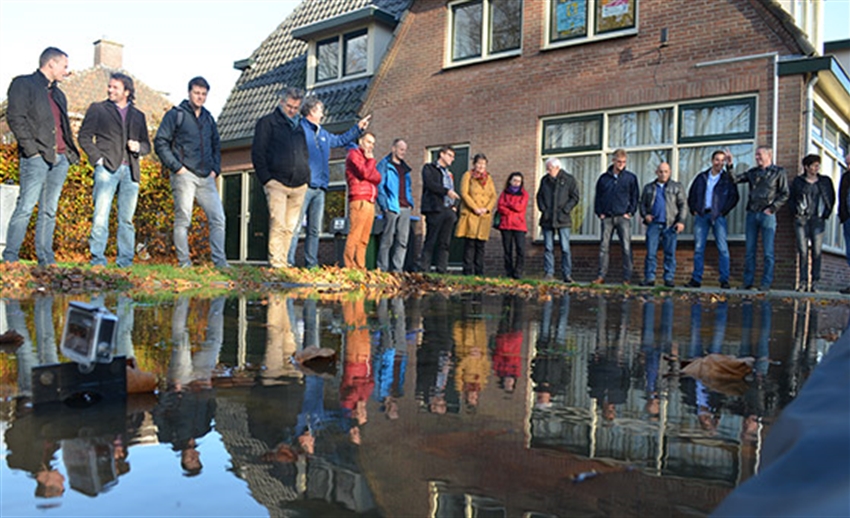Climate-proofing Hoogeveen impact project
The municipality of Hoogeveen aimed to develop a strategy to climate-proof the Hoogeveen city centre. This strategy needs to be implemented in plans and projects covering the Hoogeveen city centre.
Results
The municipal authorities and the district water board have conducted a stress test of the city centre area in order to map out the issues at play. The main challenge is to take the proper steps on the basis of the outcomes of this test. In order to gain a proper picture of the potential adaptive measures, a masterclass has been developed, with the support of the spatial adaptation incentive programme, for staff active in the fields of greenery, sewerage, water, and spatial planning. The masterclass had them set to work concretely on climate-proofing Hoogeveen. In addition, the participants were familiarised with the entire spectrum of climate adaptation, and measures were field-tested.
Hoogeveen has been selected as an impact project because of the scale of its issues, which is similar to that of many other municipalities. The masterclass structure could ultimately generate an appropriate formula for other municipalities to embark on the “ambition” step with their own organisations in a practical manner.

Masterclass Session 1: Analysis
All of a sudden, the lecture room was filled with office and field staff of the district water board, engineers from consultancies, municipal consultants of various disciplines, and a representative from the Ministry. “Analysis” requires looking, studying, and asking questions. That is exactly what the participants did in the three sub-projects that together constitute the impact project. In this first session, the outcomes of the three sub-projects (precipitation stress test, heat stress test, and a water structure design) were extensively shared with all those present. The invitation already clearly indicated: “I am taking another view of the city”. And if that invitation comes with a pair of 3D spectacles stapled to it, people will be stimulated to come and see. The precipitation stress test model has been converted to 3D with the aid of the University of Groningen.
Masterclass Session 2: Ambition
One month after the 3D session in Groningen, the Meppel district water board hosted the second session, focused on “Ambition”. Some five years ago, the municipality of Meppel paved the Ezinge neighbourhood with water-permeable material. Up until now, the municipality has opted for a maintenance programme similar to that of regular pavement, i.e., without any additional sweeping, scrubbing, or preventive cleaning. It was interesting, therefore, to find out whether this pavement still serves its purpose, especially because some municipal and water board staff had shared the idea that water-permeable pavement does not work at all. Let alone if it is not properly maintained.
For the purpose of the masterclass, students from the Hanze University of Applied Sciences fenced off and dyked a section of one of the streets. This section was flooded in the presence of the masterclass participants. This provided everyone with a clear view of the matter, and warranted the conclusion that the street is actually pervious to water. This was confirmed several days later, once the logger data had been analysed. The figures did not quite match those found at the start, but still the result was amply satisfactory.
This afternoon took the edge of many ghost stories and generated many new insights. Myths and fairy tales concerning certain climate-resilient designs were unravelled under the motto of “facing the facts”. This provided those present with ample scope for continued collective thought. It paved the way for the final session.
Masterclass Session 3: Action
The participants spent the final session in the heart of the location around which everything revolved: Hoogeveen. In order to ensure a dynamic continuation, the organisation opted for an active session featuring four different desks.
Two desks consisted of maps featuring the locations marked as important in the “analysis” session. The Hoogeveen squares occupied centre stage, and an important traffic junction in the Hoogeveen ring road was spotlighted. From slowly dreaming about solutions, the participants could return to the restrictions of reality. This generated fascinating insights into the different ideas and creativity of a range of professional disciplines, with occasionally quite objective views of the situation. At times, it also guided professional specialists into another, interesting direction. At the last desk, Johan Bouma of Wareco Engineers explained the water structure. The participants could indicate the opportunities they identified for the neighbourhoods in the immediate vicinity of the structure. Once again, various disciplines viewed the matter from different perspectives. The outcomes have proven valuable and practicable.
Towards the conclusion of the first round, the alderman and district water board member responsible pulled up a chair. They also experienced personally that taking a multi-disciplinary view of certain taskings is both difficult and challenging.
Contact person
Thomas Klomp
Municipality of Hoogeveen
0528-291175
